Abstract
Precursor cytotoxic T lymphocytes are activated upon interaction with antigen and interleukin 2. The development of the mature killer cell phenotype is achieved by the transcription of a number of function related genes including those encoding a family of cytotoxic cell proteases (CCP). Two of these proteases, CCP1 and CCP2 encoded by C11 and B10, are shown in this report to contain cell-specific transcriptional regulatory elements within their 5'-flanking regions. Two positive regulatory sequences were mapped for C11 (-682 to -427 and -243 to -112) and one for B10 (-279 to -189). In addition each flanking region contains a region of DNA (B10 -1617 to -1049 and C11 -427 to -243) that has a negative influence on transcription. The positive regions do not appear to correspond to any previously characterized regulatory elements but do map to the same region as DNase I hypersensitive sites. When ligated to heterologous promoters these elements can still stimulate transcription but cell-specificity of expression is lost. In addition the conbination of positive regulatory region and promoter is important for the stimulatory effect. The ability of these regulatory sequences to function and to determine cell-specific transcription does not appear to be an intrinsic property but also depends upon the context.
Full text
PDF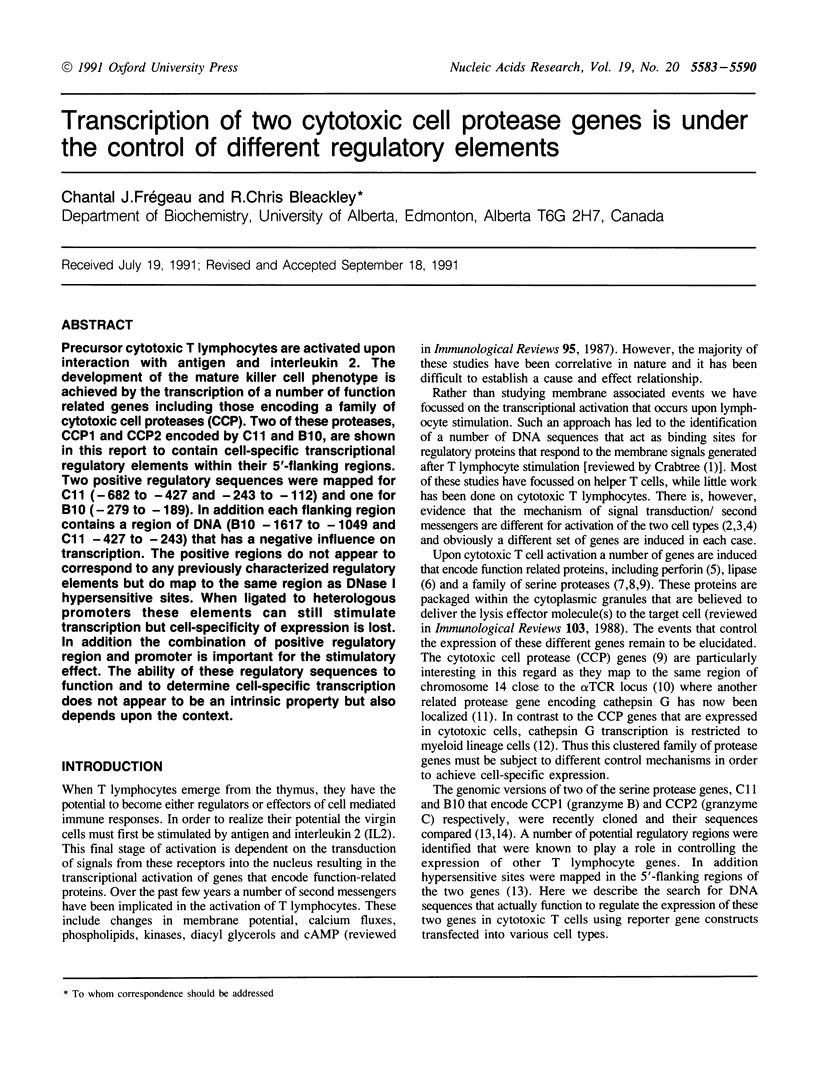
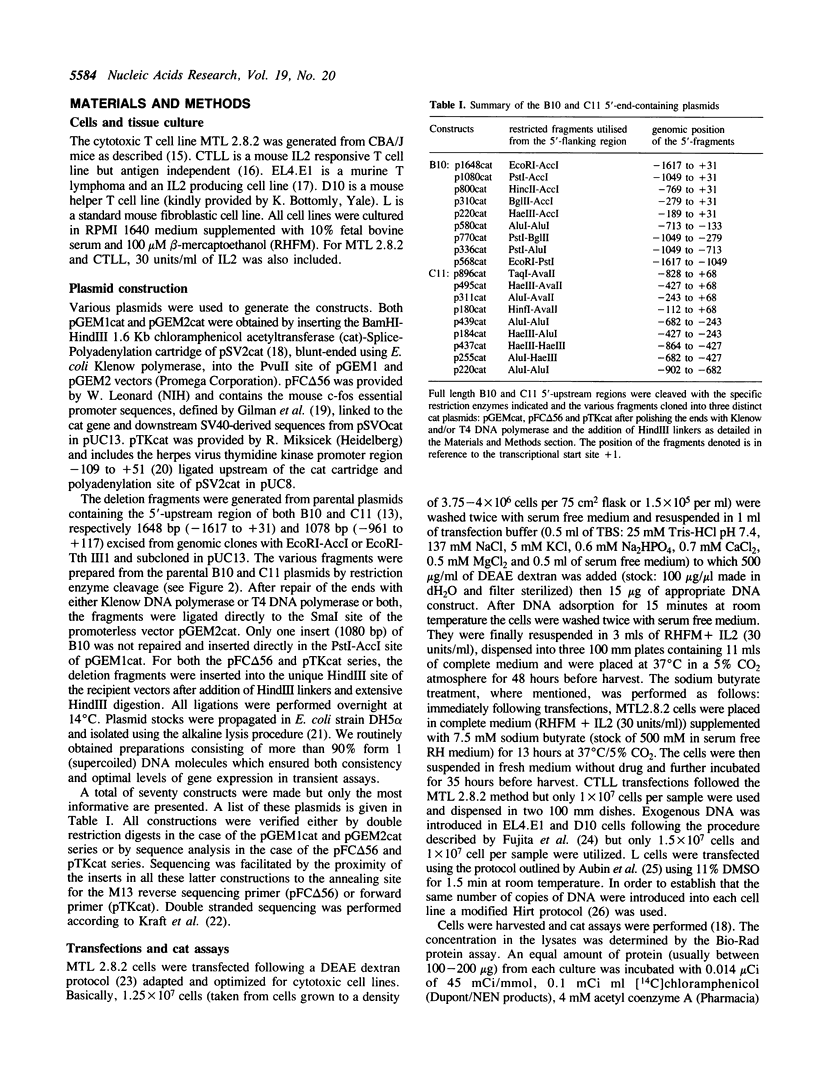
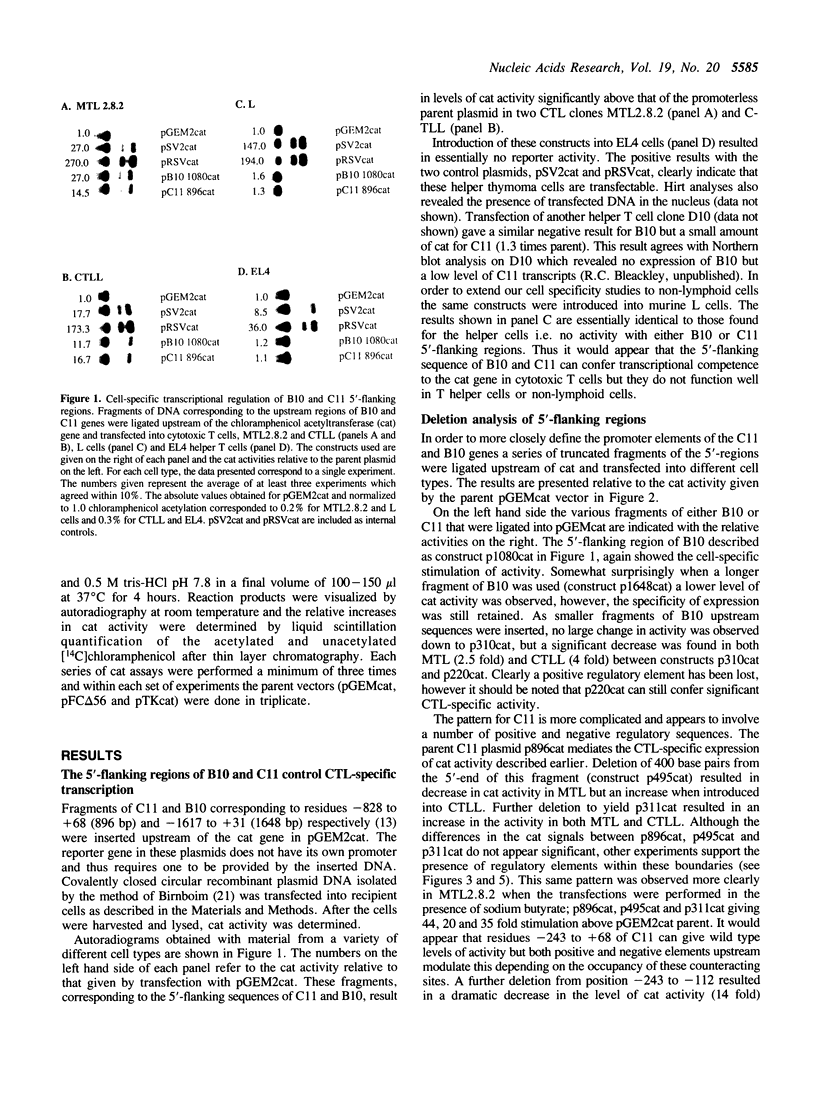
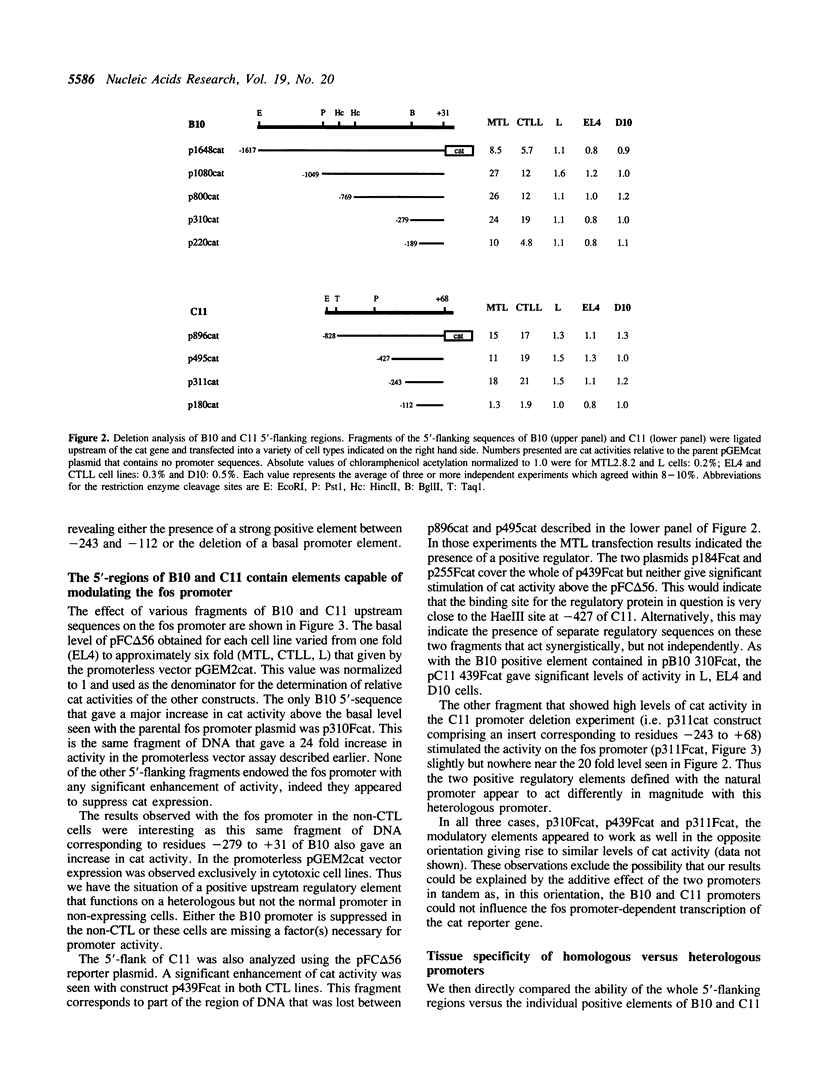
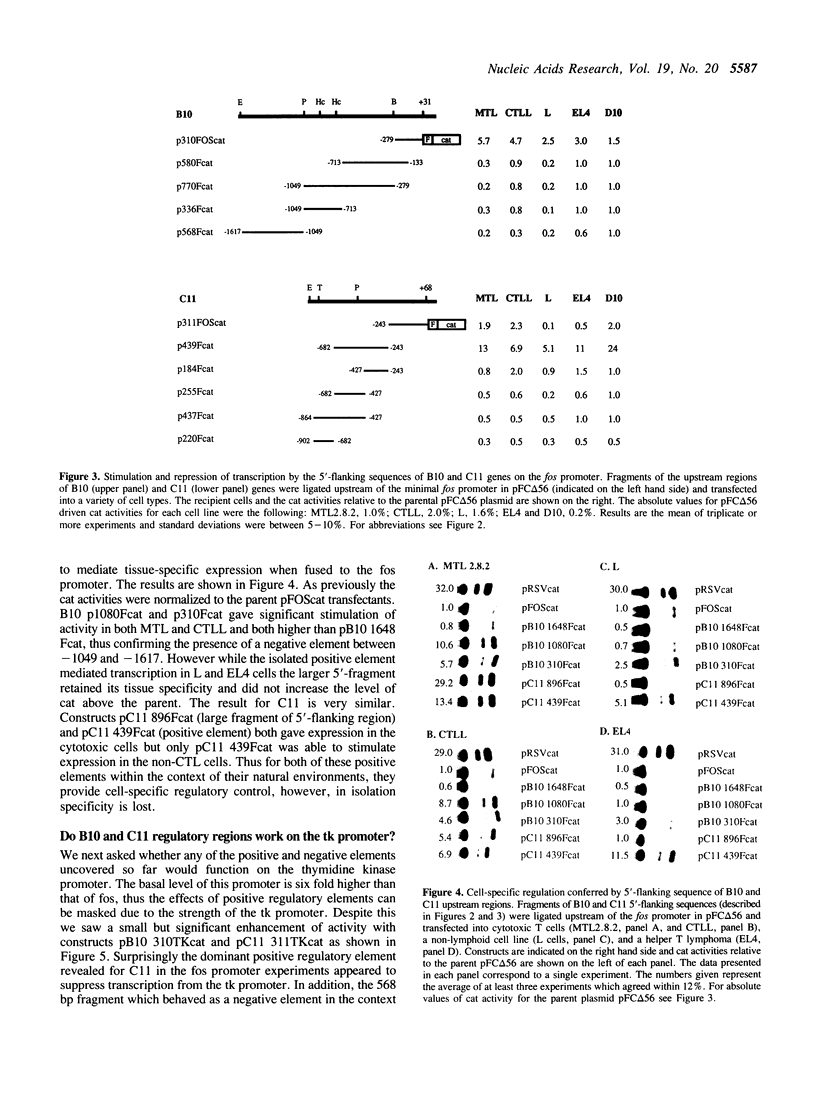
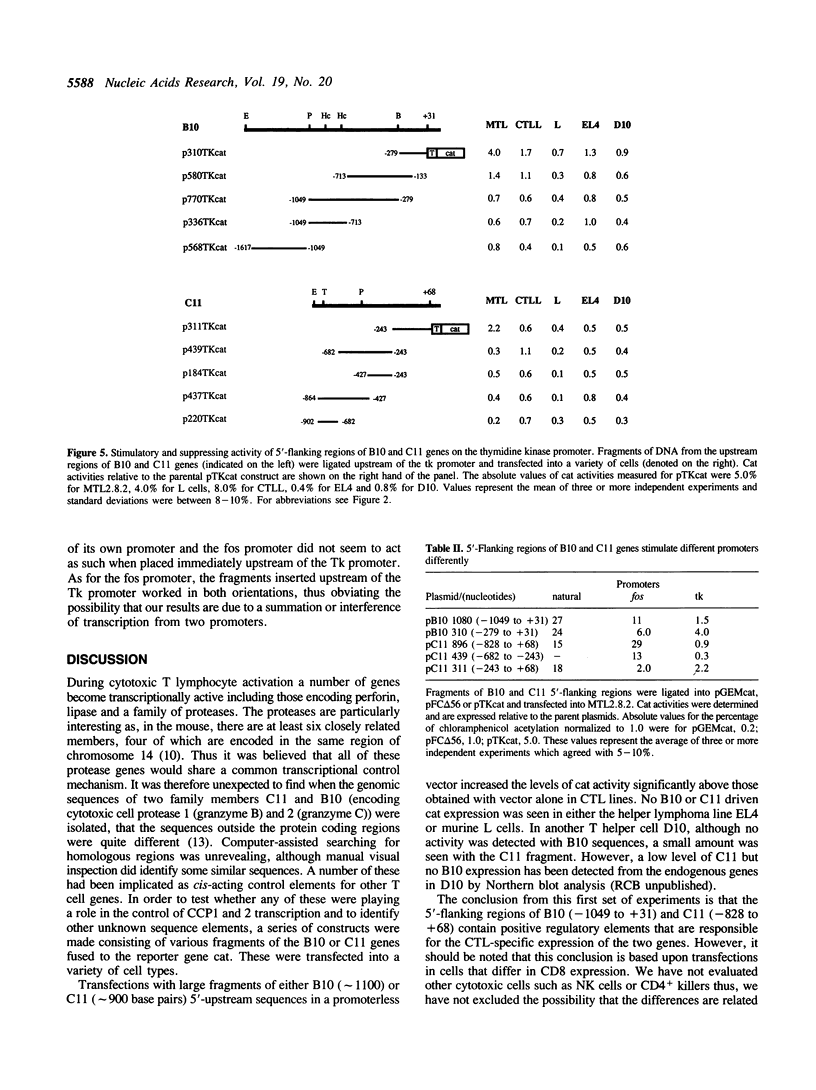
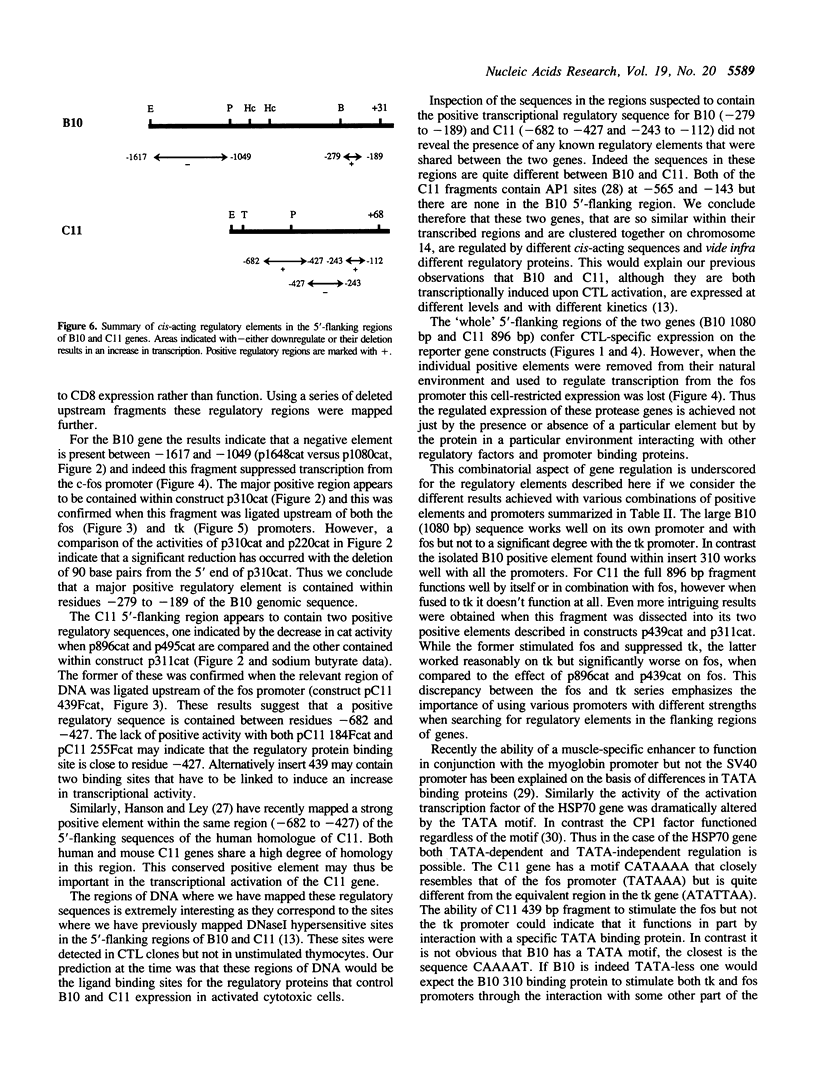
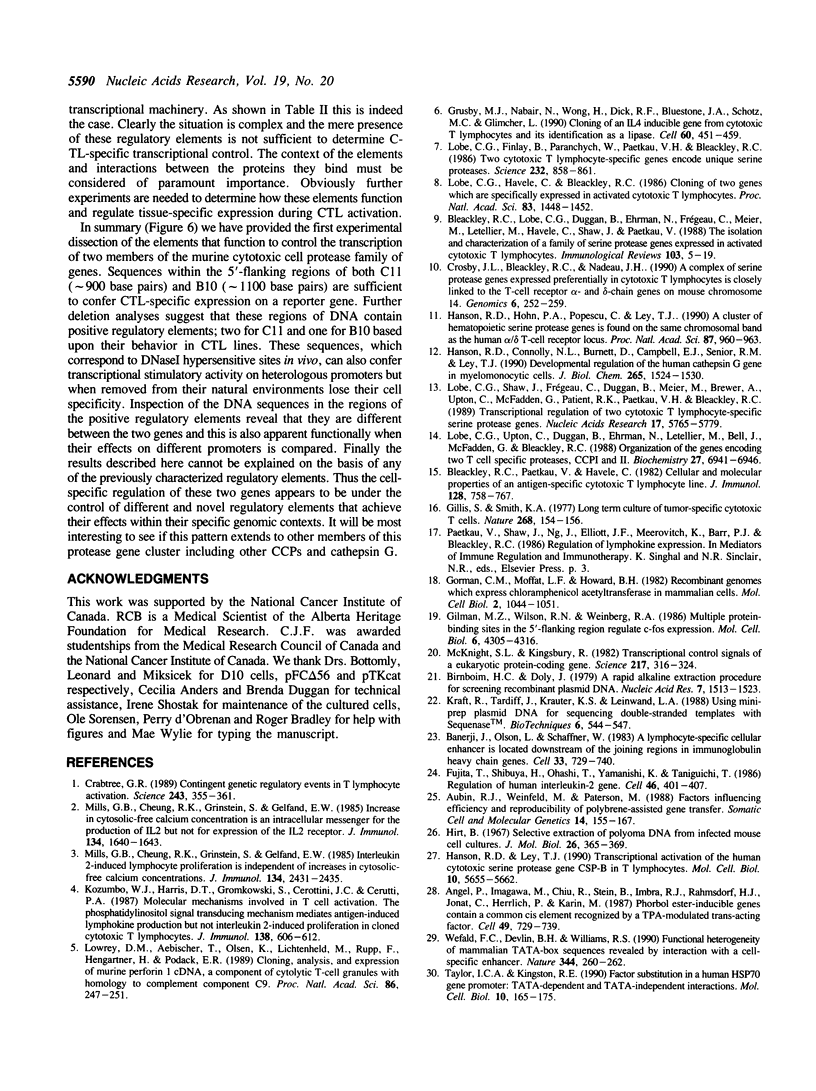
Images in this article
Selected References
These references are in PubMed. This may not be the complete list of references from this article.
- Angel P., Imagawa M., Chiu R., Stein B., Imbra R. J., Rahmsdorf H. J., Jonat C., Herrlich P., Karin M. Phorbol ester-inducible genes contain a common cis element recognized by a TPA-modulated trans-acting factor. Cell. 1987 Jun 19;49(6):729–739. doi: 10.1016/0092-8674(87)90611-8. [DOI] [PubMed] [Google Scholar]
- Aubin R. J., Weinfeld M., Paterson M. C. Factors influencing efficiency and reproducibility of polybrene-assisted gene transfer. Somat Cell Mol Genet. 1988 Mar;14(2):155–167. doi: 10.1007/BF01534401. [DOI] [PubMed] [Google Scholar]
- Banerji J., Olson L., Schaffner W. A lymphocyte-specific cellular enhancer is located downstream of the joining region in immunoglobulin heavy chain genes. Cell. 1983 Jul;33(3):729–740. doi: 10.1016/0092-8674(83)90015-6. [DOI] [PubMed] [Google Scholar]
- Birnboim H. C., Doly J. A rapid alkaline extraction procedure for screening recombinant plasmid DNA. Nucleic Acids Res. 1979 Nov 24;7(6):1513–1523. doi: 10.1093/nar/7.6.1513. [DOI] [PMC free article] [PubMed] [Google Scholar]
- Bleackley R. C., Havele C., Paetkau V. Cellular and molecular properties of an antigen-specific cytotoxic T lymphocyte line. J Immunol. 1982 Feb;128(2):758–767. [PubMed] [Google Scholar]
- Bleackley R. C., Lobe C. G., Duggan B., Ehrman N., Fregeau C., Meier M., Letellier M., Havele C., Shaw J., Paetkau V. The isolation and characterization of a family of serine protease genes expressed in activated cytotoxic T lymphocytes. Immunol Rev. 1988 Mar;103:5–19. doi: 10.1111/j.1600-065x.1988.tb00746.x. [DOI] [PubMed] [Google Scholar]
- Crabtree G. R. Contingent genetic regulatory events in T lymphocyte activation. Science. 1989 Jan 20;243(4889):355–361. doi: 10.1126/science.2783497. [DOI] [PubMed] [Google Scholar]
- Crosby J. L., Bleackley R. C., Nadeau J. H. A complex of serine protease genes expressed preferentially in cytotoxic T-lymphocytes is closely linked to the T-cell receptor alpha- and delta-chain genes on mouse chromosome 14. Genomics. 1990 Feb;6(2):252–259. doi: 10.1016/0888-7543(90)90564-b. [DOI] [PubMed] [Google Scholar]
- Fujita T., Shibuya H., Ohashi T., Yamanishi K., Taniguchi T. Regulation of human interleukin-2 gene: functional DNA sequences in the 5' flanking region for the gene expression in activated T lymphocytes. Cell. 1986 Aug 1;46(3):401–405. doi: 10.1016/0092-8674(86)90660-4. [DOI] [PubMed] [Google Scholar]
- Gillis S., Smith K. A. Long term culture of tumour-specific cytotoxic T cells. Nature. 1977 Jul 14;268(5616):154–156. doi: 10.1038/268154a0. [DOI] [PubMed] [Google Scholar]
- Gilman M. Z., Wilson R. N., Weinberg R. A. Multiple protein-binding sites in the 5'-flanking region regulate c-fos expression. Mol Cell Biol. 1986 Dec;6(12):4305–4316. doi: 10.1128/mcb.6.12.4305. [DOI] [PMC free article] [PubMed] [Google Scholar]
- Gorman C. M., Moffat L. F., Howard B. H. Recombinant genomes which express chloramphenicol acetyltransferase in mammalian cells. Mol Cell Biol. 1982 Sep;2(9):1044–1051. doi: 10.1128/mcb.2.9.1044. [DOI] [PMC free article] [PubMed] [Google Scholar]
- Grusby M. J., Nabavi N., Wong H., Dick R. F., Bluestone J. A., Schotz M. C., Glimcher L. H. Cloning of an interleukin-4 inducible gene from cytotoxic T lymphocytes and its identification as a lipase. Cell. 1990 Feb 9;60(3):451–459. doi: 10.1016/0092-8674(90)90596-7. [DOI] [PubMed] [Google Scholar]
- Hanson R. D., Connolly N. L., Burnett D., Campbell E. J., Senior R. M., Ley T. J. Developmental regulation of the human cathepsin G gene in myelomonocytic cells. J Biol Chem. 1990 Jan 25;265(3):1524–1530. [PubMed] [Google Scholar]
- Hanson R. D., Hohn P. A., Popescu N. C., Ley T. J. A cluster of hematopoietic serine protease genes is found on the same chromosomal band as the human alpha/delta T-cell receptor locus. Proc Natl Acad Sci U S A. 1990 Feb;87(3):960–963. doi: 10.1073/pnas.87.3.960. [DOI] [PMC free article] [PubMed] [Google Scholar]
- Hanson R. D., Ley T. J. Transcriptional activation of the human cytotoxic serine protease gene CSP-B in T lymphocytes. Mol Cell Biol. 1990 Nov;10(11):5655–5662. doi: 10.1128/mcb.10.11.5655. [DOI] [PMC free article] [PubMed] [Google Scholar]
- Hirt B. Selective extraction of polyoma DNA from infected mouse cell cultures. J Mol Biol. 1967 Jun 14;26(2):365–369. doi: 10.1016/0022-2836(67)90307-5. [DOI] [PubMed] [Google Scholar]
- Kozumbo W. J., Harris D. T., Gromkowski S., Cerottini J. C., Cerutti P. A. Molecular mechanisms involved in T cell activation. II. The phosphatidylinositol signal-transducing mechanism mediates antigen-induced lymphokine production but not interleukin 2-induced proliferation in cloned cytotoxic T lymphocytes. J Immunol. 1987 Jan 15;138(2):606–612. [PubMed] [Google Scholar]
- Kraft R., Tardiff J., Krauter K. S., Leinwand L. A. Using mini-prep plasmid DNA for sequencing double stranded templates with Sequenase. Biotechniques. 1988 Jun;6(6):544-6, 549. [PubMed] [Google Scholar]
- Lobe C. G., Finlay B. B., Paranchych W., Paetkau V. H., Bleackley R. C. Novel serine proteases encoded by two cytotoxic T lymphocyte-specific genes. Science. 1986 May 16;232(4752):858–861. doi: 10.1126/science.3518058. [DOI] [PubMed] [Google Scholar]
- Lobe C. G., Havele C., Bleackley R. C. Cloning of two genes that are specifically expressed in activated cytotoxic T lymphocytes. Proc Natl Acad Sci U S A. 1986 Mar;83(5):1448–1452. doi: 10.1073/pnas.83.5.1448. [DOI] [PMC free article] [PubMed] [Google Scholar]
- Lobe C. G., Shaw J., Fregeau C., Duggan B., Meier M., Brewer A., Upton C., McFadden G., Patient R. K., Paetkau V. Transcriptional regulation of two cytotoxic T lymphocyte-specific serine protease genes. Nucleic Acids Res. 1989 Jul 25;17(14):5765–5779. doi: 10.1093/nar/17.14.5765. [DOI] [PMC free article] [PubMed] [Google Scholar]
- Lobe C. G., Upton C., Duggan B., Ehrman N., Letellier M., Bell J., McFadden G., Bleackley R. C. Organization of two genes encoding cytotoxic T lymphocyte-specific serine proteases CCPI and CCPII. Biochemistry. 1988 Sep 6;27(18):6941–6946. doi: 10.1021/bi00418a040. [DOI] [PubMed] [Google Scholar]
- Lowrey D. M., Aebischer T., Olsen K., Lichtenheld M., Rupp F., Hengartner H., Podack E. R. Cloning, analysis, and expression of murine perforin 1 cDNA, a component of cytolytic T-cell granules with homology to complement component C9. Proc Natl Acad Sci U S A. 1989 Jan;86(1):247–251. doi: 10.1073/pnas.86.1.247. [DOI] [PMC free article] [PubMed] [Google Scholar]
- McKnight S. L., Kingsbury R. Transcriptional control signals of a eukaryotic protein-coding gene. Science. 1982 Jul 23;217(4557):316–324. doi: 10.1126/science.6283634. [DOI] [PubMed] [Google Scholar]
- Mills G. B., Cheung R. K., Grinstein S., Gelfand E. W. Increase in cytosolic free calcium concentration is an intracellular messenger for the production of interleukin 2 but not for expression of the interleukin 2 receptor. J Immunol. 1985 Mar;134(3):1640–1643. [PubMed] [Google Scholar]
- Mills G. B., Cheung R. K., Grinstein S., Gelfand E. W. Interleukin 2-induced lymphocyte proliferation is independent of increases in cytosolic-free calcium concentrations. J Immunol. 1985 Apr;134(4):2431–2435. [PubMed] [Google Scholar]
- Taylor I. C., Kingston R. E. Factor substitution in a human HSP70 gene promoter: TATA-dependent and TATA-independent interactions. Mol Cell Biol. 1990 Jan;10(1):165–175. doi: 10.1128/mcb.10.1.165. [DOI] [PMC free article] [PubMed] [Google Scholar]
- Wefald F. C., Devlin B. H., Williams R. S. Functional heterogeneity of mammalian TATA-box sequences revealed by interaction with a cell-specific enhancer. Nature. 1990 Mar 15;344(6263):260–262. doi: 10.1038/344260a0. [DOI] [PubMed] [Google Scholar]




